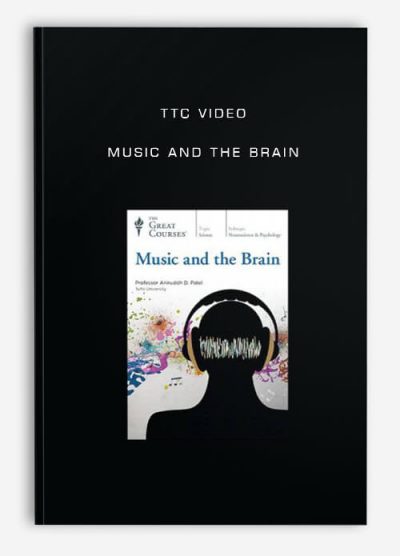TTC Video – Music and the Brain
$29.00
- Description
Description
TTC Video – Music and the Brain
**More information:
Get TTC Video – Music and the Brain at tradingcoursezone.com
Description:
Music surrounds us–and we wouldn’t have it any other way. An exhilarating orchestral crescendo can bring tears to our eyes and send shivers down our spines. Background swells add emotive punch to movies and TV shows. Organists at ballgames bring us together, cheering, to our feet. Parents croon soothingly to infants.
And our fondness has deep roots: we have been making music since the dawn of culture. More than 30,000 years ago early humans were already playing bone flutes, percussive instruments and jaw harps–and all known societies throughout the world have had music. Indeed, our appreciation appears to be innate. Infants as young as two months will turn toward consonant, or pleasant, sounds and away from dissonant ones [see box on page 42]. And the same kinds of pleasure centers light up in a person’s brain whether he or she is getting chills listening to a symphony’s denouement or eating chocolate or having sex or taking cocaine.
Therein lies an intriguing biological mystery: Why is music–universally beloved and uniquely powerful in its ability to wring emotions–so pervasive and important to us? Could its emergence have enhanced human survival somehow, such as by aiding courtship, as Geoffrey F. Miller of the University of New Mexico has proposed? Or, as suggested by Robin I. M. Dunbar of the University of Liverpool in England, did it originally help us by promoting social cohesion in groups that had grown too large for grooming? On the other hand, to use the words of Harvard University’s Steven Pinker, is music just auditory cheesecake–a happy accident of evolution that happens to tickle the brain’s fancy?
Neuroscientists don’t yet have the ultimate answers. But in recent years we have begun to gain a firmer understanding of where and how music is processed in the brain, which should lay a foundation for answering evolutionary questions. Collectively, studies of patients with brain injuries and imaging of healthy individuals have unexpectedly uncovered no specialized brain center for music. Rather music engages many areas distributed throughout the brain, including those that are usually involved in other kinds of cognition. The active areas vary with the person’s individual experiences and musical training. The ear has the fewest sensory cells of any sensory organ–3,500 inner hair cells occupy the ear versus 100 million photoreceptors in the eye. Yet our mental response to music is remarkably adaptable; even a little study can retune the way the brain handles musical inputs.
Inner Songs
UNTIL THE ADVENT of modern imaging techniques, scientists gleaned insights about the brain’s inner musical workings mainly by studying patients–including famous composers–who had experienced brain deficits as a result of injury, stroke or other ailments. For example, in 1933 French composer Maurice Ravel began to exhibit symptoms of what might have been focal cerebral degeneration, a disorder in which discrete areas of brain tissue atrophy. His conceptual abilities remained intact–he could still hear and remember his old compositions and play scales. But he could not write music. Speaking of his proposed opera Jeanne d’Arc, Ravel confided to a friend, … this opera is here, in my head. I hear it, but I will never write it. It’s over. I can no longer write my music. Ravel died four years later, following an unsuccessful neurosurgical procedure. The case lent credence to the idea that the brain might not have a specific center for music.
The experience of another composer additionally suggested that music and speech were processed independently. After suffering a stroke in 1953, Vissarion Shebalin, a Russian composer, could no longer talk or understand speech, yet he retained the ability to write music until his death 10 years later. Thus, the supposition of independent processing appears to be true, although more recent work has yielded a more nuanced understanding, relating to two of the features that music and language share: both are a means of communication, and each has a syntax, a set of rules that govern the proper combination of elements (notes and words, respectively). According to Aniruddh D. Patel of the Neurosciences Institute in San Diego, imaging findings suggest that a region in the frontal lobe enables proper construction of the syntax of both music and language, whereas other parts of the brain handle related aspects of language and music processing.
Imaging studies have also given us a fairly fine-grained picture of the brain’s responses to music. These results make the most sense when placed in the context of how the ear conveys sounds in general to the brain [see box on opposite page]. Like other sensory systems, the one for hearing is arranged hierarchically, consisting of a string of neural processing stations from the ear to the highest level, the auditory cortex. The processing of sounds, such as musical tones, begins with the inner ear (cochlea), which sorts complex sounds produced by, say, a violin, into their constituent elementary frequencies. The cochlea then transmits this information along separately tuned fibers of the auditory nerve as trains of neural discharges. Eventually these trains reach the auditory cortex in the temporal lobe. Different cells in the auditory system of the brain respond best to certain frequencies; neighboring cells have overlapping tuning curves so that there are no gaps. Indeed, because neighboring cells are tuned to similar frequencies, the auditory cortex forms a frequency
The response to music per se, though, is more complicated. Music consists of a sequence of tones, and perception of it depends on grasping the relations between sounds. Many areas of the brain are involved in processing the various components of music. Consider tone, which encompasses both the frequencies and loudness of a sound. At one time, investigators suspected that cells tuned to a specific frequency always responded the same way when that frequency was detected.
But in the late 1980s David Diamond, Thomas M. McKenna and I, working in my laboratory at the University of California, Irvine, raised doubts about that notion when we studied contour, which is the pattern of rising and falling pitches that is the basis for all melodies. We constructed melodies consisting of different contours using the same five tones and then recorded the responses of single neurons in the auditory cortices of cats. We found that cell responses (the number of discharges) varied with the contour. Responses depended on the location of a given tone within a melody; cells may fire more vigorously when that tone is preceded by other tones rather than when it is the first. Moreover, cells react differently to the same tone when it is part of an ascending contour (low to high tones) than when it is part of a descending or more complex one. These findings show that the pattern of a melody matters: processing in the auditory system is not like the simple relaying of sound in a telephone or stereo system.
Most research has focused on melody, but rhythm (the relative lengths and spacing of notes), harmony (the relation of two or more simultaneous tones) and timbre (the characteristic difference in sound between two instruments playing the same tone) are also of interest. Studies of rhythm have concluded that one hemisphere is more involved, although they disagree on which hemisphere. The problem is that different tasks and even different rhythmic stimuli can demand different processing capacities. For example, the left temporal lobe seems to process briefer stimuli than the right temporal lobe and so would be more involved when the listener is trying to discern rhythm while hearing briefer musical sounds.
The situation is clearer for harmony. Imaging studies of the cerebral cortex find greater activation in the auditory regions of the right temporal lobe when subjects are focusing on aspects of harmony. Timbre also has been assigned a right temporal lobe preference. Patients whose temporal lobe has been removed (such as to eliminate seizures) show deficits in discriminating timbre if tissue from the right, but not the left, hemisphere is excised. In addition, the right temporal lobe becomes active in normal subjects when they discriminate between different timbres.
Brain responses also depend on the experiences and training of the listener. Even a little training can quickly alter the brain’s reactions. For instance, until about 10 years ago, scientists believed that tuning was fixed for each cell in the auditory cortex. Our studies on contour, however, made us suspect that cell tuning might be altered during learning so that certain cells become extra sensitive to sounds that attract attention and are stored in memory.
To find out, Jon S. Bakin, Jean-Marc Edeline and I conducted a series of experiments during the 1990s in which we asked whether the basic organization of the auditory cortex changes when a subject learns that a certain tone is somehow important. Our group first presented guinea pigs with many different tones and recorded the responses of various cells in the auditory cortex to determine which tones produced the greatest responses. Next, we taught the subjects that a specific, nonpreferred tone was important by making it a signal for a mild foot shock. The guinea pigs learned this association within a few minutes. We then determined the cells’ responses again, immediately after the training and at various times up to two months later. The neurons’ tuning preferences had shifted from their original frequencies to that of the signal tone. Thus, learning retunes the brain so that more cells respond best to behaviorally significant sounds. This cellular adjustment process extends across the cortex, editing the frequency map so that a greater area of the cortex processes important tones. One can tell which frequencies are important to an animal simply by determining the frequency organization of its auditory cortex [see box on opposite page].
The retuning was remarkably durable: it became stronger over time without additional training and lasted for months. These findings initiated a growing body of research indicating that one way the brain stores the learned importance of a stimulus is by devoting more brain cells to the processing of that stimulus. Although it is not possible to record from single neurons in humans during learning, brain-imaging studies can detect changes in the average magnitude of responses of thousands of cells in various parts of the cortex. In 1998 Ray Dolan and his colleagues at University College London trained human subjects in a similar type of task by teaching them that a particular tone was significant. The group found that learning produces the same type of tuning shifts seen in animals. The long-term effects of learning by retuning may help explain why we can quickly recognize a familiar melody in a noisy room and also why people suffering memory loss from neurodegenerative diseases such as Alzheimer’s can still recall music that they learned in the past.
Even when incoming sound is absent, we all can listen by recalling a piece of music. Think of any piece you know and play it in your head. Where in the brain is this music playing? In 1999 Andrea R. Halpern of Bucknell University and Robert J. Zatorre of the Montreal Neurological Institute at McGill University conducted a study in which they scanned the brains of nonmusicians who either listened to music or imagined hearing the same piece of music. Many of the same areas in the temporal lobes that were involved in listening to the melodies were also activated when those melodies were merely imagined.
Well-Developed Brains
STUDIES OF MUSICIANS have extended many of the findings noted above, dramatically confirming the brain’s ability to revise its wiring in support of musical activities. Just as some training increases the number of cells that respond to a sound when it becomes important, prolonged learning produces more marked responses and physical changes in the brain. Musicians, who usually practice many hours a day for years, show such effects–their responses to music differ from those of nonmusicians; they also exhibit hyperdevelopment of certain areas in their brains.
Related Products
-
-86%
 Add to cartQuick View
Add to cartQuick View -
-84%
 Add to cartQuick View
Add to cartQuick View -
-85%
 Add to cartQuick View
Add to cartQuick View








